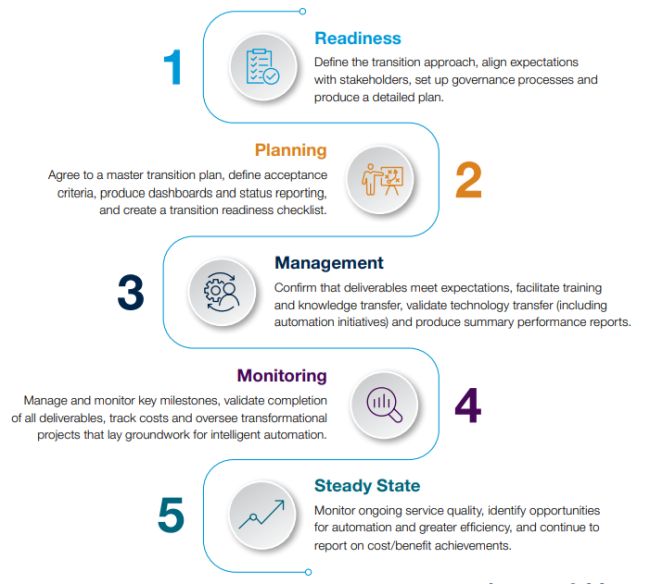The Transition Life Cycle
The hard work of designing a future GBS operating environment is done, and a lower cost, more efficient future way of working, utilizing offshore delivery and intelligent automation, has been agreed upon. The opportunity for higher quality, defined by faster turnaround times and fewer mistakes, can be realized — all at a considerably reduced cost. However, driving such success requires that the transition be planned thoroughly and executed in every detail.
Initially, companies are excited about the opportunity and have high expectations. They feel confident in the solution that has been developed and negotiated, and are typically confident in the ability of the offshore team, whether internal or from the supplier. The approach of the company is often "hands off," and while this is initially comfortable, mistakes will inevitably occur. Questions start to be raised about the wisdom of the new operating model, but few understand the complexity and implication of the change. Furthermore, all of the impacted stakeholders are rarely identified, nor is a detailed communication plan prepared and implemented.
The decline in confidence is in parallel with efforts on the ground, typically in an offshore location, to get the operation up and running, staff recruited and trained, technology set up and new tools implemented to drive efficiency. Typically, at around 90 to 120 days into the transition the weight and complexity of the transition becomes fully apparent, and the governance, planning, core vision and value proposition are all questioned. The decline in confidence needs to be reversed, with strong, effective and dedicated leadership, both in the offshore location and at company headquarters.
When poorly executed, the transition can spiral downward, with a continued decline in confidence from users and management, and despite the best efforts of the offshore team the program can stall. In this event, the promising opportunity to drive efficiency and reduce cost can be held back or even lost, but with good planning, reporting and execution, things can be brought back on track.
Transitions Are Complex, and Detailed Planning Is Critical
Transition is a process by which services are transferred from their current operating environment to a new model. The transfer involves changes in people, process and technology. The process is complex, requiring great attention to detail, and the risk of failure is high. However, understanding the transition process and how new technologies will be introduced in due course is critical for success.
Transition involves change in people, processes and technology.
While the greatest complaints usually center around performance and staffing issues, much of the responsibility for successful transition and service rests with the company itself. It is critically important that the stakeholders are aware and aligned with the plan and that they are supportive. A detailed plan that includes milestones is essential; the transition must include regular reporting of progress and remedies where there is slippage. Managing the transition and subsequent delivery is a full-time effort that involves process owners, subject matter experts, change management capabilities and program management, all of which need to be funded to mitigate risk and to ensure success. Finally, to maintain continued stakeholder support, internal reporting on an ongoing basis on the cost/benefits achieved is required, together with demonstration of improved overall service, via customer satisfaction surveys and reports on service level achievements.
All stakeholders must be aligned with and support the plan. The company is ultimately responsible for managing the transition.
Five Steps in Transition
We advocate five steps in transition, recognizing that there is some overlap between the phases. The five phases are as follows:

The success of the transition process is critically dependent on a robust and thoughtfully created retained organization, where the services provided in an alternative location fit "hand in glove." It is critical to define and map each process in detail, including assigning global process owners with overall responsibility. In addition — this is a key underlying success factor for driving greater process efficiency — the process should incorporate generative artificial intelligence into process delivery and reporting.
A robust approach to transition with active management and strong reporting at each stage of the process is essential to managing risk and providing a firm foundation for efficiency.
For maximum efficiency, generative AI should be utilized in process delivery and reporting.
Originally published by 20 March, 2024
The content of this article is intended to provide a general guide to the subject matter. Specialist advice should be sought about your specific circumstances.


